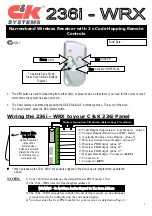
air ran
itter to ecei er
(Always test unit prior to installation)
The transmitter wor s with the E A D
receiver & basic programming
calls for the user to pair the transmitters with a receiver & select a melody for
the transmitter to instruct the receiver to play when triggered.
For quick setup, however, each zone defaults to a basic "ding-dong" sound allowing you to
easily pair the transmitter for a faster set up process.
Figure 1
Battery In ta ation
han in the one e ody
By default, each zone is programmed by the factory to play the ding-dong
sound
1. Hold down the "zone" button until you hear a short tone & all LEDs on
front panel of receiver are red (approx 3 seconds). The zone you are
programming will flash.
2. ress the "volume" button to scroll through the 12 available melodies
for selection. nce you find a melody you li e, move to step 3.
3. ress the "zone" button to scroll to the next zone & repeat step 2 to
program a melody to other zones.
4.
nce you have programmed a melody to all necessary zones, move to
step 5.
5. Hold down the "zone" button until you hear a short tone sound (approx
3 seconds) notifying the receiver is out of melody programming mode.
Owner’s Manual
This device complies with Part 15 of the FCC rules, Operation of this device is subject
to the following conditions: 1. This device may not cause harmful interference. 2. This
device must accept any interference, including interference that may cause unde-
sired operation.
e
ote
•
Each receiver is capable of pairing with four (4) transmitters per zone.
•
Each zone features 1 x 12 D output.
•
utput duration for the 12 D output may be set to 5 sec, 1 sec, 1
min, & 2 min. The receiver features 1 x Form relay assignable to one
or multiple zones & will ta e on the duration of the 12 D output.
•
olume control 4 levels plus mute, plus off.
•
Each transmitter must be paired to a zone on the receiver.
•
Each zone is programmed to the "ding dong" sound from the factory.
ser may change this melody.
•
hen transmitter battery is low, it sends a signal to the receiver when
triggered & the corresponding LED on the receiver will continue to
flash for 1 minutes.
•
The E A
T is a push button transmitter that must be
programmed to a E A compatible receiver to operated.
•
ush button measures 3.
H x 2.25 x 1. 5 D.
•
The halo ring around the center push will illuminate dimly for
visibility at night (this feature consumes very little power.)
•
hen triggered (center push button is pressed) the center halo
illuminates brightly for approximately 2 seconds.
•
The push button is outdoor rated and contains a silicone gas et to
eep moisture out. ount with the small weep hole pointing down
to ensure any moisture in the unit evaporates out.
Figure
2
1.
n the E A D
receiver, hold down the "mode" (left button in figure 3
below) button until you hear a short tone sound & the "zone 1" LED flashes
(approx 3 sec).
2. f you are programming the transmitter to zone 1 press the button on your
transmitter. ou will hear the receiver play a short musical note (zone 1 will
continue to flash).
3. To program a transmitter to a different zone, press the "zone" button on
the receiver to scroll to the appropriate zone . The zone you want to
program will flash. epeat step 2 above.
4.
nce you have programmed all the zones move to the next step.
5. To exit program mode, hold down the "mode" button until you hear a short
tone sound (approx 3 sec)
1. pen the front cover by inserting the included screwdriver into the
s uare hole on the bottom of the unit (figure 1) & gently push & then
separate the top & bottom halves of the case.
2. emove top part of case from lower part of case (figure 2).
3. nstall the included 245 A battery into the holder with positive ( ) side
of the battery facing up (figure 2).
4. Test the battery by pressing the center push. The green halo should
illuminate for approximately 2 seconds, signaling transmission. ote
rogram the push button to a compatible receiver
to mounting the push
button.
o
e
te
The volume button on the side of the receiver controls the four different volume
levels, mutes & turns off the receiver. Pushing the volume button controls these
functions.
•
hen all four zone LED lights are red, this indicates maximum volume.
•
Three zone LED lights indicate the third volume level.
•
Two zone LED lights indicate the second volume level.
•
ne zone LED light indicates the minimum volume level.
•
o zone LED lights & a red power indicator light means the
Figure
3




















